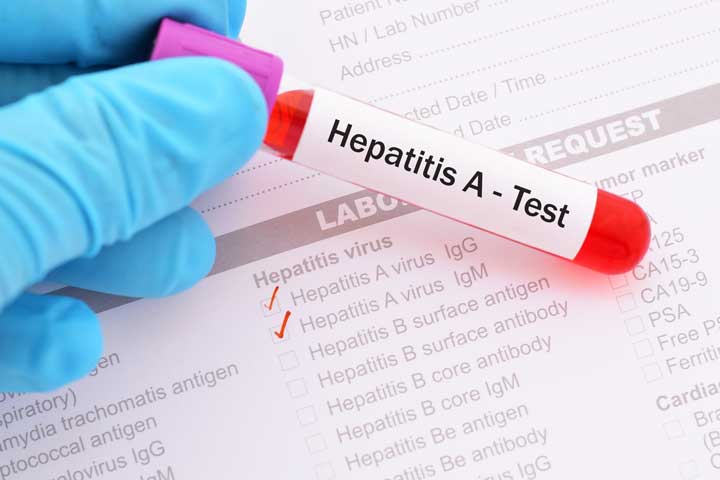Be sure your knowledge is up-to-date.
HEALTHCARE WORKERS are well aware of their risk for hepatitis B from exposure through occupational needlesticks and bodily fluid. And they know about the widespread availability of effective vaccines and postexposure prophylaxis protocols to reduce the risk. But far less attention is paid to hepatitis A. That lack of attention is dangerous because the incidence of the infection is on the rise: The Centers for Disease Control and Prevention (CDC) reports that hepatitis A infections in the United States increased by 294% from 2016 through 2018.
Unlike the bloodborne pathogen spread of hepatitis B, hepatitis A is transmitted via the fecal-oral route. Contaminated food has been implicated as the source of large-scale outbreaks in the past, but the U.S. outbreak, which started in 2016 with cases in Michigan and San Diego, has occurred mainly among those with close contact with infected individuals (homeless individuals, those who use drugs, men who have sex with men, and recently incarcerated people). As of July 19, 2019, the CDC has collected reports on 22,295 cases of hepatitis A from 25 states; 13,184 patients have been hospitalized (59%) and 216 have died. As the outbreaks continue, these numbers will likely rise.
With the high number of cases being reported and the relatively high hospitalization rate, healthcare workers should have a heightened index of suspicion for hepatitis A when evaluating patients. They also should know that the virus is highly contagious.
What are the basics of hepatitis A?
According to the CDC, hepatitis A symptoms in adults and children often appear abruptly and include fever, fatigue, loss of appetite, nausea, vomiting, abdominal pain, dark (brown) urine, diarrhea, light-colored stools, joint pain, and jaundice. The asymptomatic incubation period ranges from 15 to 50 days, with symptoms lasting about 2 months for most patients. Complete recovery is generally seen within 6 months, but the current outbreak has been associated with high morbidity and hospitalization. Unlike other viral forms of hepatitis, hepatitis A is considered a self-limiting disease without a chronic state. (See Definitions and classifications.)
Definitions and classifications
The case definition for acute hepatitis A is:
Clinical criteria
An acute illness with:
• discrete onset of signs or symptoms (fever, headache, malaise, anorexia, nausea, vomiting, diarrhea, abdominal pain, or dark urine)
AND
• jaundice or elevated serum aminotransferase levels ≥3.0 mg/dL OR elevated serum alanine aminotransferase (ALT) levels >200 IU/L
AND
• absence of a more likely diagnosis
Laboratory criteria
• Immunoglobulin M (IgM) antibody to hepatitis A virus (anti-HAV) positive OR
• Nucleic acid amplification test (NAAT; such as polymerase chain reaction [PCR] or genotyping) for hepatitis A virus RNA positive
Epidemiologic link
• Contact (e.g., household or sexual) with a laboratory confirmed hepatitis A case 15 to 50 days before onset of symptoms.
A hepatitis A case is classified as confirmed:
• if it meets the clinical case definition and is laboratory confirmed (IgM anti-HAV positive)
OR
• if hepatitis A virus RNA is detected by NAAT (such as PCR or genotyping)
OR
• if it meets the clinical criteria and occurs in a person who had contact (e.g., household or sexual) with a laboratory- confirmed hepatitis A case 15 to 50 days before onset of symptoms.
Source: Centers for Disease Control and Prevention. Hepatitis A, acute 2019 case definition.
cdc.gov/nndss/conditions/hepatitis-a-acute/case-definition/2019/
What are we learning about hepatitis A epidemiology?
Hepatitis A case volume across the country has been high. Kentucky has had the highest number of cases, with 4,793 cases reported, including 2,311 hospitalizations (48%) and 59 deaths between August 1, 2017, and July 13, 2019. Other states with high totals are Ohio (3,234 between January 1, 2018, and July 29, 2019), West Virginia (2,533 between March 19, 2018, and July 17, 2019), and Florida (2,586 between January 1, 2018, and July 31, 2019). State-by-state statistics are available at cdc.gov/hepatitis/outbreaks/2017March-HepatitisA.htm.
A review of San Diego’s outbreak data shows the range of the infection. For example, 28% of reported cases weren’t associated with homelessness or sex between men, and an additional 10% had no identified risk factors.
How is hepatitis A being controlled?
Most of the outbreak control efforts—including disseminating information and vaccines, prophylaxis to certain populations, and enhanced cleaning protocols—have been led by public health departments, sometimes in collaboration with healthcare organizations. Efforts by the Indiana State Department of Health (ISDH), according to ISDH food and waterborne epidemiologist Nicole Stone, MPH, include creating a “strike team” of vaccinators who are deployed wherever they’re needed to assist with vaccinating at-risk groups, including at community clinics for drug users, homeless individuals, and people who are under- or uninsured, as well as in county jail clinics. The ISDH also works with hospitals that have been particularly hard hit by the outbreak, sending vaccines to be administered to at-risk patients who come into the emergency department and their contacts.
Family Health Centers of San Diego (FHCSD) collaborated with health department and community contacts to increase outreach and prevention efforts. The strategies included offering vaccinations to high-risk patients, reporting cases and contacts, and providing postexposure prophylaxis. The success of this work has led to San Diego declaring the outbreak over.
What if hepatitis A is suspected?
When hepatitis A is suspected, follow CDC contact precaution and vaccination guidelines
Contact precautions
The CDC’s Guideline for Isolation Precautions: Preventing Transmission of Infectious Agents in Healthcare Settings (2007) includes a recommendation that any incontinent or diapered patient with acute diarrhea with a likely infectious cause be cared for with contact precautions, including gown and gloves for anyone entering the area where the patient is being cared for and disinfecting any items before use with another patient.
For nondiapered or continent patients, standard precautions are indicated, including scrupulous hand hygiene and ensuring surfaces and equipment are appropriately cleaned. Some organizations with a significant number of hepatitis A cases have reviewed their cleaning protocols to ensure the disinfectants they’re using are effective against the virus. Search the Environmental Protection Agency database (iaspub.epa.gov/apex/pesticides/f?p=PPLS:1 ) by product name to determine if what you’re using is effective.
Vaccinations
One dose of single-antigen hepatitis A vaccine has been shown to control outbreaks and provides up to 95% seroprotection in healthy individuals for up to 11 years. Identifying contacts and providing postexposure prophylaxis (along with reinforcing infection control basics such as handwashing) also are critical to controlling outbreaks. The CDC recommends that people who recently have been exposed to hepatitis A and who haven’t been vaccinated should receive one dose of single-antigen hepatitis A vaccine or immunoglobulin within 2 weeks after exposure; specific recommendations vary based on the individual’s health status and age. The CDC also recommends that all states and territories conduct surveillance on acute cases of viral hepatitis, and many states require it in their communicable disease reporting rules.
Following routine vaccination requirements for hepatitis A is important. These are listed at immunize.org/askexperts/experts_hepa.asp#recommendations and include all children at age 1 year, men who have sex with men, homeless people, people who have bloodclotting disorders or chronic liver disease, and those who use illegal drugs.
Continuing vigilance
The current hepatitis A outbreak has affected nearly half of U.S. states. Efforts to identify at-risk populations and leverage community relationships and partnerships with public health agencies and healthcare providers have shown promise in slowing the infection’s spread and ending the outbreak. Continuing basic hygiene vigilance, vaccination of at-risk populations, and careful contact investigation and prophylaxis—along with prompt reporting of suspected cases—are crucial to reducing the future impact of hepatitis A. Lessons learned during these efforts will be useful for future control strategies.
Michelle DeVries is senior infection control officer for Methodist Hospitals in Gary, Indiana, and is an adjunct research fellow at Griffith University in Australia. She serves on the speakers’ bureaus for Access Scientific, Becton Dickinson, Ethicon, and Eloquest.
Selected references
Centers for Disease Control and Prevention. Increase in hepatitis A virus infections—United States, 2013-2018. MMWR. May 10, 2019. cdc.gov/mmwr/volumes/68/wr/mm6818a2.htm?s_cid=mm6818a2_w
Centers for Disease Control and Prevention. Viral hepatitis: Frequently asked questions: Hepatitis A outbreaks. April 26, 2019. cdc.gov/hepatitis/outbreaks/FAQs-HepAOutbreaks.htm
Centers for Disease Control and Prevention. Viral hepatitis: Widespread outbreaks of hepatitis A across the United States. July 15,
2019. cdc.gov/hepatitis/outbreaks/2017March-HepatitisA.htm
Duncan L. A community clinic’s response to a hepatitis A outbreak. Am J Infect Control. 2018;46(9):1057-9.
Kaye D. News: Hepatitis A outbreak in the United States. Clin Infect Dis. 2019;68(1):i.
Siegel JD, Rhinehart E, Jackson M, Chiarello L. 2007 Guideline for Isolation Precautions: Preventing Transmission of Infectious Agents in Healthcare Settings. Updated July 2019. cdc.gov/infectioncontrol/pdf/guidelines/isolation-guidelines-H.pdf
Wooten DA. Forgotten but not gone: Learning from the hepatitis A outbreak and public health response in San Diego. Top Antivir Med. 2019;26(4):117-21.





2 Comments.
USEFUL INFO TO ENCOURAGE HEALTH CARE WORKERS TO GET VACCINE
2 doses of Havrix should be given 0,6months for lifelong protection